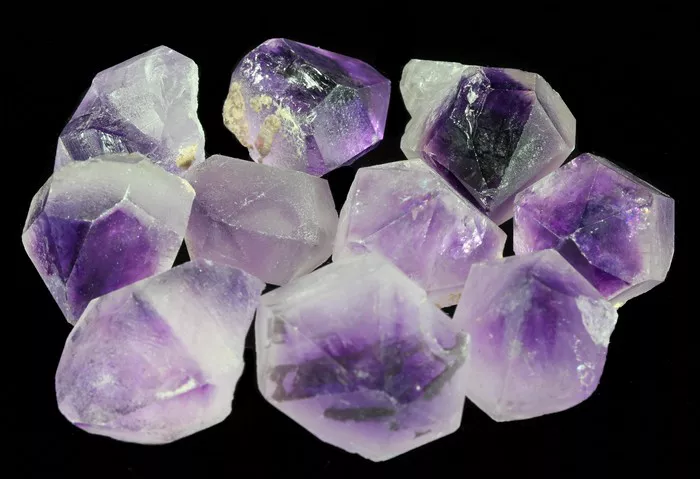Amethyst, with its captivating hues ranging from pale lilac to deep purple, has enchanted humanity for centuries. Revered for its purported metaphysical properties and stunning beauty, this quartz variant is a favorite among mineral enthusiasts and jewelry aficionados alike. However, in a market flooded with imitations and synthetics, determining the authenticity of raw amethyst can be challenging. This guide aims to demystify the process, offering insights into the key characteristics that define genuine amethyst specimens.
The Geological Genesis of Amethyst
Before delving into authentication methods, it’s essential to understand how amethyst forms. Amethyst is a variety of quartz, which is one of the most abundant minerals in the Earth’s crust. Its distinctive purple coloration is attributed to the presence of iron impurities and irradiation during formation.
Amethyst typically occurs in geodes, which are spherical rock cavities lined with crystals. These geodes form in igneous rocks, such as basalt, or occasionally in sedimentary rocks. The process begins when gas bubbles become trapped in molten rock as it cools, leaving behind cavities. Over time, groundwater rich in silica seeps into these cavities, depositing quartz crystals. The presence of iron in the groundwater, along with natural irradiation, gives rise to the characteristic purple color of amethyst.
Distinguishing Real from Fake: Key Indicators
Color and Clarity
Authentic raw amethyst exhibits a range of purple hues, from pale lavender to deep violet. The color should be evenly distributed throughout the crystal, with no patches of intense color or areas that are completely colorless. Natural amethyst often contains inclusions, which are solid or fluid-filled cavities within the crystal. These inclusions can include minerals like hematite or goethite, as well as gas bubbles. However, excessive cloudiness or a uniform, unnatural color may indicate a synthetic or treated specimen.
Transparency and Luster
In its purest form, amethyst is transparent to translucent, allowing light to pass through to some degree. The crystal should exhibit a vitreous or glass-like luster when polished. Synthetic amethyst, on the other hand, may appear too perfect, with a uniform color and overly glossy surface.
Crystal Structure
Amethyst belongs to the trigonal crystal system, forming six-sided prisms terminated by six-sided pyramids. Natural amethyst crystals often exhibit a hexagonal symmetry when viewed from above. Synthetic amethyst may lack this natural symmetry or show evidence of being grown in a laboratory environment, such as unnatural growth patterns or seed plates.
Hardness and Scratch Resistance
Quartz, including amethyst, has a Mohs hardness of 7, making it relatively scratch-resistant. Genuine amethyst should not easily scratch or chip under normal handling. However, be cautious, as some imitations, like glass, can also have a hardness of around 5.5, which could lead to confusion.
UV Fluorescence
When exposed to ultraviolet (UV) light, natural amethyst often exhibits fluorescence. This can vary from a faint glow to a more intense reaction, depending on the specimen. Synthetic amethyst may also fluoresce, but the color and intensity can differ from natural amethyst.
Testing Techniques: A Closer Look
While visual inspection is a valuable first step, several testing techniques can help verify the authenticity of raw amethyst:
Polarized Light Microscopy
This technique involves examining a thin slice of the specimen under a polarized light microscope. Natural amethyst will display characteristic interference patterns due to its crystal structure, which can help distinguish it from synthetic materials.
Spectroscopy
Spectroscopic analysis, such as infrared (IR) or Raman spectroscopy, can provide valuable insights into the molecular composition of a sample. Natural amethyst will exhibit characteristic absorption bands, particularly in the IR spectrum, due to its iron impurities.
X-Ray Diffraction (XRD)
XRD can determine the crystal structure of a sample by analyzing the diffraction pattern produced when X-rays interact with its atoms. Natural amethyst will produce a specific pattern indicative of its quartz crystal structure.
Specific Gravity
Measuring the specific gravity of a specimen can help differentiate between materials of similar appearance. Natural amethyst typically has a specific gravity of around 2.65, while synthetic materials may have different values.
Caring for Your Amethyst
Whether you’re a collector or simply appreciate the beauty of amethyst, proper care can help preserve its natural allure:
Avoid Harsh Chemicals: Amethyst is sensitive to acids and alkaline solutions, which can damage its surface. Clean your amethyst with mild soap and warm water, using a soft brush to remove dirt.
Store Properly: To prevent scratching or damage, store your amethyst away from harder materials and direct sunlight. Consider wrapping it in a soft cloth or keeping it in a jewelry box.
Recharge in Moonlight: Many believe that amethyst can benefit from the energy of the full moon. Place your amethyst outdoors or on a windowsill during a full moon to cleanse and recharge its energy.
In conclusion, raw amethyst continues to captivate us with its natural beauty and intriguing geological origins. By understanding its unique characteristics and employing the right testing techniques, we can ensure that our amethyst specimens are genuine. Whether you’re a seasoned collector or a novice enthusiast, the allure of amethyst is undeniable, making it a timeless addition to any collection or jewelry box.


